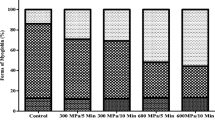Abstract
Chicken breast from the same animal (n=4) was subjected to high hydrostatic pressures of 200, 400 or 600 MPa for 5 min at 10 °C, and subsequently stored at 5 °C vacuum-packed or packed in air for 2 or 8 days in darkness. Following heating to 80 °C for 10 min in order to mimic the cooking of a chill-stored, high-pressure processed poultry product, formation of secondary lipid oxidation products were measured as thiobarbituric acid reactive substances (TBARS) and as volatiles by solid phase micro extraction and gas chromatography with mass spectroscopic detection (SPME-GC-MS). High-pressure treatment at 400 MPa and especially 600 MPa led to a significant increase in secondary lipid oxidation products in the cooked product when compared to 200 MPa treatment and a non-pressurised control. The storage period had a significant influence on the formation of secondary lipid oxidation products (especially in the presence of oxygen in the packs stored for 8 days). Hexanal, octanal and nonanal were identified as lipid oxidation products, and may all be used as indicators of the development of “press-over-flavour” as shown by multivariate analysis. Hexanal showed particularly good correlation (R 2=0.93) with the TBARS-values.




Similar content being viewed by others
References
Jiménez-Colmenero F, Borderias AJ (2003) Eur Food Res Technol (2003) 217:461–465
Hansen E, Trinderup RA, Hviid M, Darré M, Skibsted LH Eur Food Res Technol (2003) 218:2–6
Cheah PB, Ledward DA (1997) J Food Sci 62:1135–1138
Dissing J, Bruun-Jensen L, Skibsted LH (1998) Z Lebensm Unters F A 205:11–13
Orlien V, Hansen E, Skibsted LH (2000) Eur Food Res Technol 211:99–104
Jensen C, Skibsted LH, Jakobsen K, Bertelsen G (1995) Poultry Sci 74:2048–2056
Cheah PB, Ledward DA (1996) Meat Sci 43:123–134
Jensen C, Engberg R, Jakobsen K, Skibsted LH, Bertelsen G (1997) Meat Sci 27:211–222
Acknowledgements
We are grateful to Henrik Schramm Rasmussen for discussions and assistance with the high pressure equipment at DTI, and to Dr. Lars Nørgaard for helpful comments on the multivariate data analysis.
Author information
Authors and Affiliations
Corresponding author
Rights and permissions
About this article
Cite this article
Wiggers, S.B., Kröger-Ohlsen, M.V. & Skibsted, L.H. Lipid oxidation in high-pressure processed chicken breast during chill storage and subsequent heat treatment: effect of working pressure, packaging atmosphere and storage time. Eur Food Res Technol 219, 167–170 (2004). https://doi.org/10.1007/s00217-004-0931-4
Received:
Revised:
Published:
Issue Date:
DOI: https://doi.org/10.1007/s00217-004-0931-4




